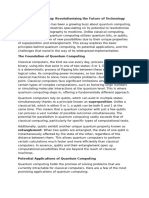Introduction to Quantum Computing
Uploaded by
snowstreet5152Introduction to Quantum Computing
Uploaded by
snowstreet5152Introduction to Quantum Computing
Abstract
Quantum computing represents a paradigm shift in computation, leveraging principles
of quantum mechanics to perform calculations beyond the capabilities of classical
computers. This paper introduces the fundamental concepts of quantum computing,
including qubits, superposition, entanglement, and quantum gates. Additionally, it
explores the historical development, current advancements, and potential
applications in various fields such as cryptography, material science, and
artificial intelligence.
1. Introduction
Quantum computing has emerged as one of the most revolutionary technological
advancements of the 21st century. Unlike classical computing, which relies on
binary logic with bits representing 0s and 1s, quantum computing utilizes quantum
bits (qubits), which can exist in multiple states simultaneously due to the
principles of superposition and entanglement. This ability enables quantum
computers to solve complex problems exponentially faster than their classical
counterparts.
2. Fundamental Concepts
Qubits: Unlike classical bits, qubits can be in a state of 0, 1, or any quantum
superposition of these states.
Superposition: A qubit can exist in multiple states simultaneously, enabling
parallel computation.
Entanglement: A unique quantum phenomenon where the state of one qubit is dependent
on another, regardless of distance.
Quantum Gates: Unlike classical logic gates, quantum gates manipulate qubits using
unitary transformations.
3. Historical Development
The theoretical foundations of quantum computing were laid by Richard Feynman and
David Deutsch in the 1980s. Over the years, companies like IBM, Google, and
startups such as D-Wave have made significant strides in building functional
quantum processors.
4. Applications of Quantum Computing
Quantum computing has promising applications in multiple fields:
Cryptography: Shor’s algorithm poses a potential threat to RSA encryption.
Optimization Problems: Quantum annealing offers solutions to complex optimization
tasks.
Drug Discovery: Quantum simulations enable precise molecular modeling for
pharmaceutical research.
Artificial Intelligence: Enhancing machine learning algorithms through quantum
computation.
5. Conclusion
Quantum computing stands at the frontier of technological innovation. While
significant challenges remain in terms of hardware stability, error correction, and
scalability, ongoing research and investment are paving the way for practical
quantum applications. As technology progresses, quantum computing may redefine
computation and problem-solving methodologies across various disciplines.
You might also like
- The Enigmatic World of Quantum Computing Revolutionizing TechnologyNo ratings yetThe Enigmatic World of Quantum Computing Revolutionizing Technology4 pages
- Understanding Quantum Computing_ Overview Applications Benefits ChallengesNo ratings yetUnderstanding Quantum Computing_ Overview Applications Benefits Challenges9 pages
- GooglesAdvancesinQuantumComputing-AComprehensiveReviewNo ratings yetGooglesAdvancesinQuantumComputing-AComprehensiveReview37 pages
- Quantum Computing: The Future of TechnologyNo ratings yetQuantum Computing: The Future of Technology1 page
- Advances in Quantum Computing and Its Potential ApplicationsNo ratings yetAdvances in Quantum Computing and Its Potential Applications3 pages
- Quantum Computing - An Overview (Personal Notes)No ratings yetQuantum Computing - An Overview (Personal Notes)4 pages
- The Marvels of Quantum Computing Unleashing Unprecedented PowerNo ratings yetThe Marvels of Quantum Computing Unleashing Unprecedented Power1 page
- QUANTUM COMPUTING AND ITS POTENTIAL DISRUPTIONSNo ratings yetQUANTUM COMPUTING AND ITS POTENTIAL DISRUPTIONS7 pages
- Exploring the Mysteries of Quantum ComputingNo ratings yetExploring the Mysteries of Quantum Computing3 pages
- Title - Quantum Computing - Unleashing The Power of The Subatomic WorldNo ratings yetTitle - Quantum Computing - Unleashing The Power of The Subatomic World2 pages
- The Impact of Quantum Computing on Modern TechnologyNo ratings yetThe Impact of Quantum Computing on Modern Technology2 pages
- R4 - The Potential of Quantum Computing in Solving Complex ProblemsNo ratings yetR4 - The Potential of Quantum Computing in Solving Complex Problems3 pages
- Class Notes: The Basics of Quantum ComputingNo ratings yetClass Notes: The Basics of Quantum Computing3 pages
- Quantum Mechanics in Computing - Principles and ApplicationsNo ratings yetQuantum Mechanics in Computing - Principles and Applications2 pages
- Quantum Computing Research Trends Report - ElsevierNo ratings yetQuantum Computing Research Trends Report - Elsevier13 pages
- Abo Shosha Et Al 2008 Paraffin Wax Emulsion As Water Repellent For Cotton Polyester Blended FabricNo ratings yetAbo Shosha Et Al 2008 Paraffin Wax Emulsion As Water Repellent For Cotton Polyester Blended Fabric11 pages
- 5 - Foundation Knowledge of Forensic Odontology Lec 1No ratings yet5 - Foundation Knowledge of Forensic Odontology Lec 115 pages
- Lecture 4.1 - Prospecting and Exploration PDF100% (1)Lecture 4.1 - Prospecting and Exploration PDF91 pages
- Format No. 16 List of Paper Setter - DCMOSNo ratings yetFormat No. 16 List of Paper Setter - DCMOS2 pages
- Production of Synthetic Fluorspar From WasteNo ratings yetProduction of Synthetic Fluorspar From Waste4 pages
- Tunnel Fire Protection: A Lost Formwork System, Using PROMATECT - HNo ratings yetTunnel Fire Protection: A Lost Formwork System, Using PROMATECT - H24 pages
- GRADE 6 MELCS For SOCIAL MEDIA TV and RADIO BASED MODALITYNo ratings yetGRADE 6 MELCS For SOCIAL MEDIA TV and RADIO BASED MODALITY11 pages
- An Insight Into Gothic Arch Tracing: July 2019No ratings yetAn Insight Into Gothic Arch Tracing: July 20197 pages
- A Study On Renewable Energy Resources in IndiaNo ratings yetA Study On Renewable Energy Resources in India39 pages
- GD&T Symbols, Definitions ASME Y14.5-2009 Training - ISO G&T Symbols 1101 Definitions - GD&T Trainers - Engineers EdgeNo ratings yetGD&T Symbols, Definitions ASME Y14.5-2009 Training - ISO G&T Symbols 1101 Definitions - GD&T Trainers - Engineers Edge8 pages

























































































